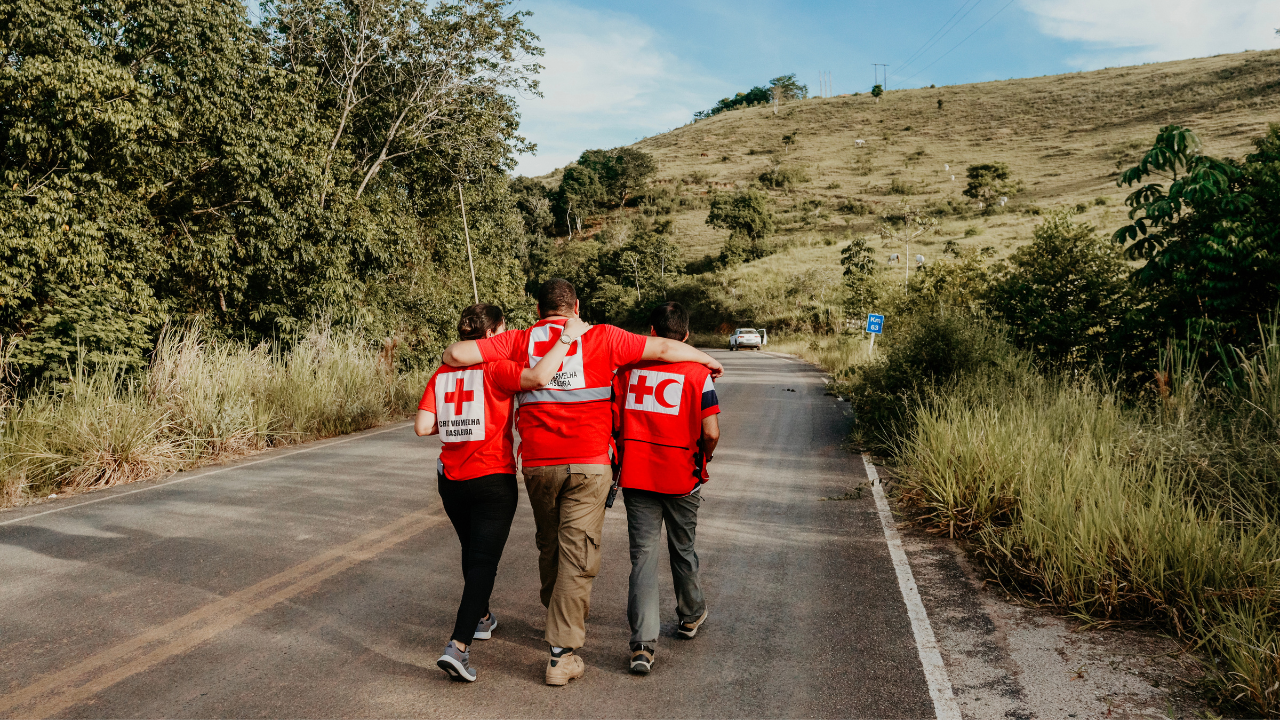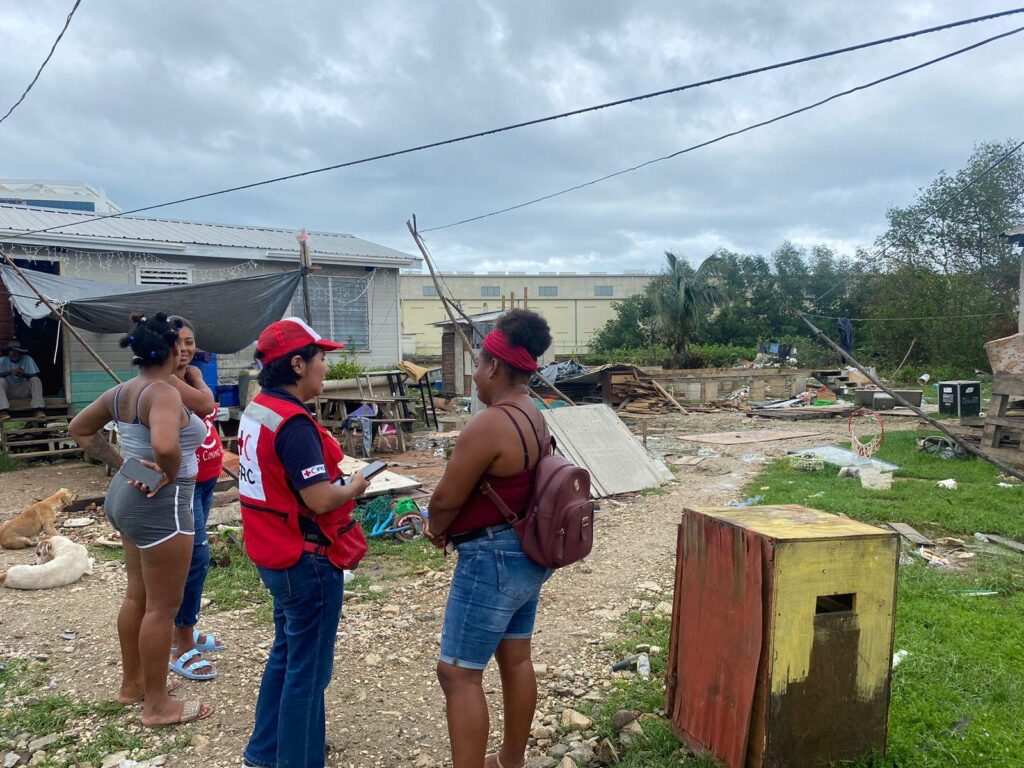
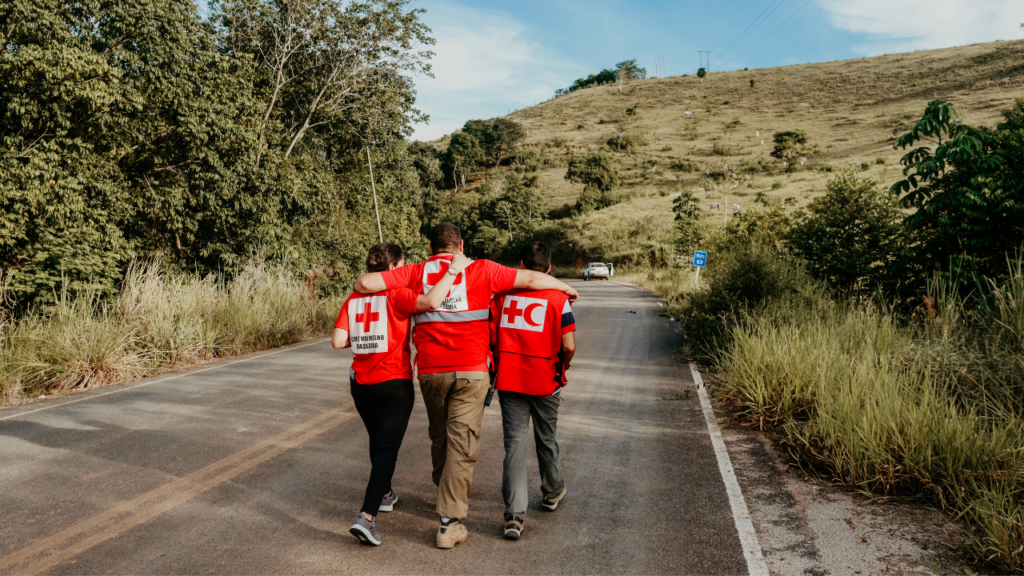
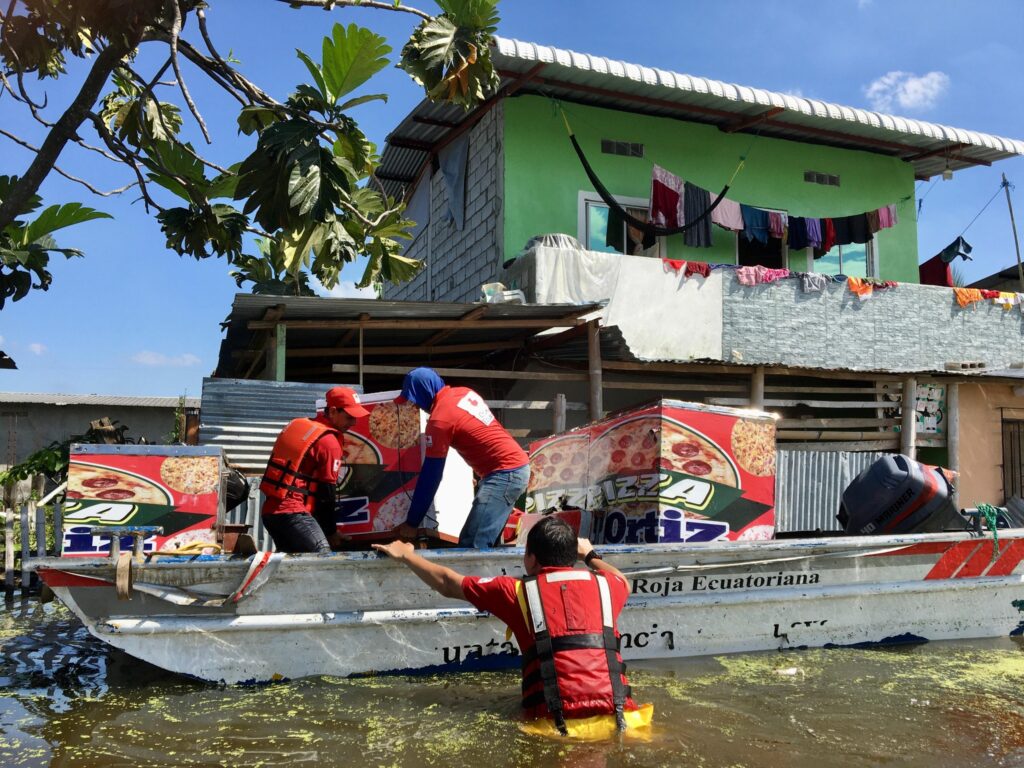
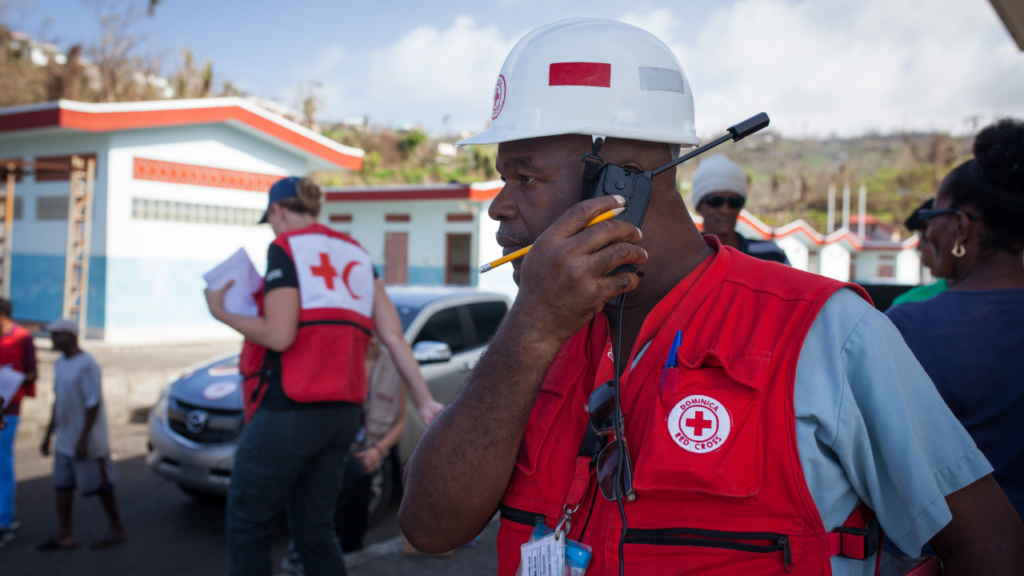
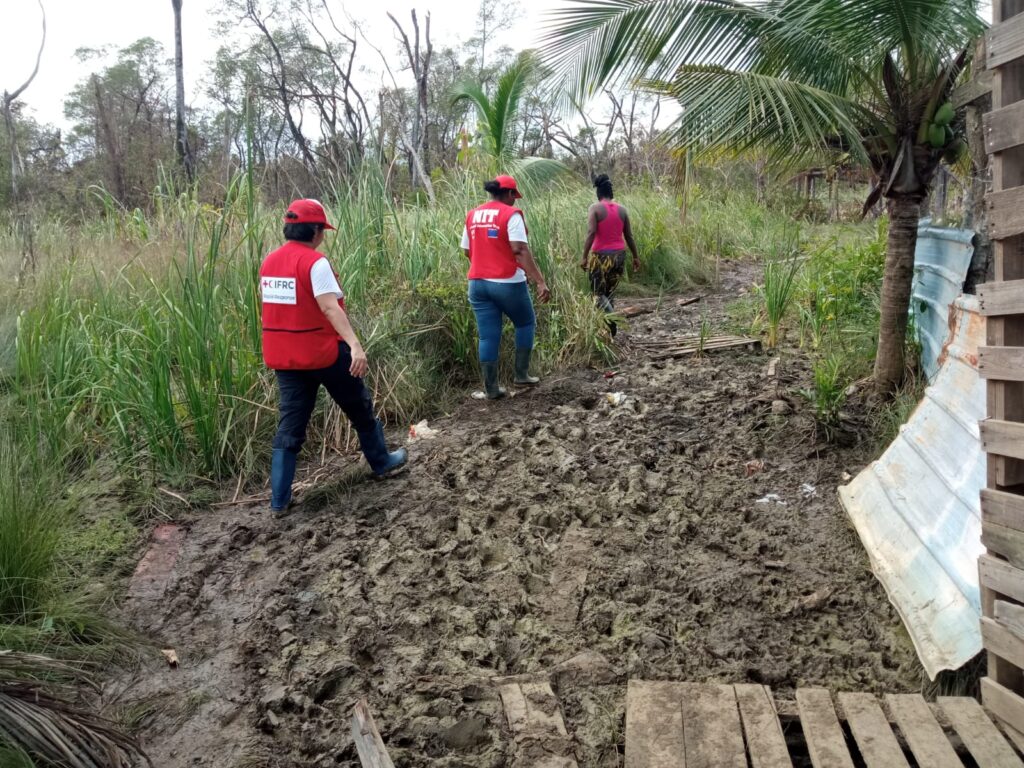
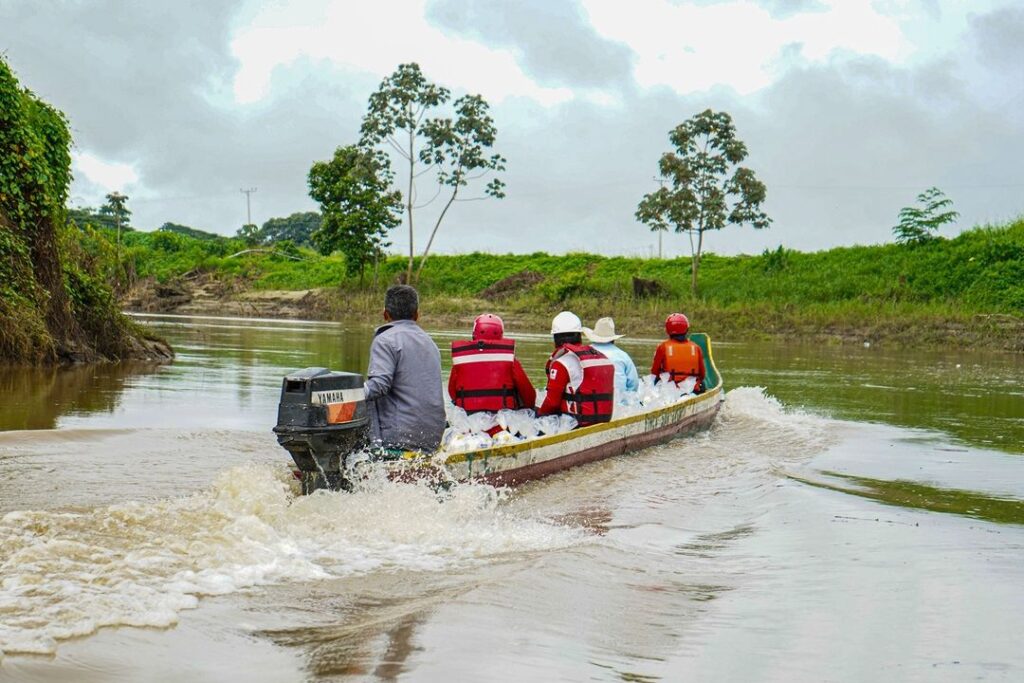
Shelter in Emergencies
In the area of shelter, IFRC plays a dual coordination and operational role to support the improvement of emergency shelter preparedness before and immediately after a disaster occurs.
Regarding shelter on hurricane preparedness and response activities in urban environments, dignified shelter should include: safety, security, health, privacy, education, integration, water and sanitation, connectivity, livelihoods, transportation. Shelter management also influences the sense of belonging and community.
The consequences of disasters on shelter and urban environments are varied. In housing, doors and windows are broken, allowing wind to enter and cause damage to roofs, infrastructure and household assets, uprooted trees can damage surrounding areas, and even the strongest structures can be damaged.
Also, the impact of flooding was mentioned, which can erode roads and bridges, cause landslides and disrupt transportation, affecting the economy and livelihoods nationally and locally. Floods can also affect water sources and supplies, increasing the risk of disease. In addition, power and communication outages can occur, disrupting essential services and affecting emergency response. Floods require a lot of money for recovery.
How can we prepare for the imminent arrival of a hurricane or storm?
The first thing is that response is determined by funding capacity. Some of the preparedness activities are: reinforcement of housing, locating host families, agreements with financial service entities for cash assistance distribution, capacity building with other agencies and local actors, equipping collective shelters, evacuation plans, prepositioning of kits, advocacy and dissemination of key messages.
How can we respond to a hurricane or storm?
In early recovery speed is key to saving lives. Actions include technical assessments, repair or refurbishment of collective shelters, relocation of displaced families, delivery of cash, delivery of household kits and temporary shelter, debris removal and recycling, capacity building to build back better and safer, and incorporation of the Community Engagement and Protection, Gender and Inclusion approaches during all stages. They also mentioned the importance of constant monitoring and evaluation to identify areas for improvement and lessons learned.
Finally, they mentioned the environmental impacts of disasters that vary from place to place. Some examples are disaster debris, fallen trees, household appliances, chemicals, pesticides. All of this debris goes into the water and contaminates it, damaging water supplies. Stagnant water increases the risk of vector-borne diseases.
These and other environmental impacts must be taken into account in all plans and actions related to housing, to reduce risk, to build better and safer, and to increase resilience to climate change.
IFRC leads the RED-LAC shelter group, which is integrated by 18 humanitarian agencies working in shelter and settlements. They have developed a Disaster Preparedness Work Plan that includes, among other actions, humanitarian partner mapping, collective shelter mapping, and capacity self-assessment at the national level.
Cash and Voucher Assistance In Emergencies
The session featured representatives from the IFRC, Dominican Republic Red Cross, Colombian Red Cross and RedRose and looked at some of the cash programmes available for national societies to utilise in emergencies.
Cash programmes collect, store and use data throughout the programme lifecycle. This includes personal data (the registration of people affected by crisis), financial data (the allocation of funds and the distribution of cash) and programme data (the status of the programme).
The IFRC has an objective to disseminate 50% of its aid through cash assistance and coupons. Through a partnership with RedRose, some National Societies have already started this process.
RedRose is a data management platform that integrates with data collection tools such as ODK/Kobo to manage data (e.g. beneficiary details, market price monitoring, post-distribution surveys) and with payment mechanisms (e.g. mobile money, remittance, e-voucher) to distribute cash assistance and enable automated reconciliation in a secured and auditable manner. The platform provides monitoring and reporting capabilities and can also be used for other assistance types such as in-kind and services.
Cash transfers provide communities with autonomy to be able to choose what they spend their money on. RedRose is present in 52 countries, reaching over 100 million people and can adapt to any context. The platform can be used as part of anticipatory actions or response actions and can also be adapted to the local language. In emergencies, RedRose could also deploy representatives to the field to provide support. Security is also a priority as there are various protection mechanisms in place including restricted access to certain private information and conformity to data protection regulations.
The Dominican Republic Red Cross and the Colombian Red Cross shared their experiences using the RedRose platform. An important lesson learned by the Dominican Republic Red Cross is that it’s important to put the family at the centre of their operations and facilitate them in the decision-making process.
For the Colombian Red Cross, with the use of the RedRose platform, they were able to significantly cut down the amount of time and administrative processes to be able to deliver cash more effectively to the affected persons. Through the platform, everything can be done automatically and allows for greater consolidation of information.
Three main recommendations for national societies which want to improve their CVA during the hurricane season are:
- Identify financial service providers in advance of emergencies. The range of providers is broad and diverse, and we can select those that provide the specific services needed in each context. Once identified, sign framework agreements with them that can be activated with agility in the event of a crisis. This will make cash assistance more agile.
- Update your knowledge of technology tools. Many of the CVA procedures were manual, but there are now platforms and tools that automate them and allow us to manage the data and provide the service in a more agile way. Identify the most relevant ones and get trained on them.
- Promote the use of RedRose in your country. This platform is compatible with different banking entities and can be integrated with various financial providers, which increases the possibility of using it in different contexts.
Public Health in Emergencies
The impact of hurricanes on the health of the most vulnerable communities and groups is undeniable, and is often exacerbated by conditions of social and economic inequality that already force people to live in high-risk situations. The IFRC has been working for decades to make health services accessible and of high quality, based on strengthening preparedness and proactive action.
To illustrate this work, the Guatemalan and Colombian Red Cross presented their public health programs in emergencies.
Both National Societies have a comprehensive health system that incorporates sexual and reproductive health care, mental health and psychosocial support, protection, gender and inclusion, epidemic control and disaster risk management.
Humanitarian actions carried out in the area of public health include: capacity assessment, delivery of humanitarian aid, immediate response in medical care and ambulance service, pre-hospital care, blood collection in emergency contexts, psychological first aid, actions to ensure access to water, sanitation and hygiene, promotion of rights and prevention of violence, cleaning and disinfection of wells, hygiene promotion, among others.
The Colombian Red Cross emphasized its efforts to bring accessible and quality health services to hard-to-reach territories through its mobile health units and the strengthening of community health.
Some of the recent emergencies in which these National Societies have intervened include hurricanes Eta and Iota, storm Julia, the eruption of the Fuego Volcano in Guatemala, the COVID-19 pandemic, and outbreaks of dengue and other vector-borne diseases.
Finally, they highlighted some lessons learned for public health care in emergencies:
- The need to care for those who care, include self-care programs for volunteers and staff.
- It is important to install capacity in the National Society, to carry out constant training and updating, not per project.
- Importance of generating Early Action Plans (EAP).
- Generate logistics and administrative management processes in advance, in order to have adequate equipment and personnel, trained and strengthened for when the emergency arrives.
- Constant coordination with partners.
- Incorporate policies and regulations that support actions and plans.
Water, Sanitation and Hygiene Promotion (WASH)
The passage of hurricanes Eta and Iota in 2020 forced our global network to strengthen and expand its capacity to respond to the needs of the millions of people affected in all the countries of Central America. One of the key areas of articulation was water, sanitation and hygiene. For example, the German Red Cross mobilized its emergency unit specialized in providing safe water, while the Honduran Red Cross rehabilitated water facilities that had been in use since Hurricane Mitch 20 years earlier.
Recognizing the power of coordinated action and the high probability that hurricanes like Eta and Iota would strike again, the Costa Rican, Guatemalan, Honduran, Panamanian and Salvadoran Red Cross and the IFRC decided to create an initiative that would allow them to multiply their capacity to provide water and sanitation services in the region.
This is how the WASH Hub came into being. Its goal is to strengthen emergency management with a WASH approach, building human and logistical capacity to anticipate and respond to various emergencies, including storms and hurricanes.
With its current inventory of resources, the WASH Hub has the capacity to produce 114 cubic meters of safe water per hour. This would serve approximately 182,400 people per day.
The initiative will receive technical and financial support from the German Red Cross during its first three years and will develop its work based on five strategic pillars: capacity building, equipment and maintenance, planning and advocacy, activation and deployment, and sustainability.
Meanwhile, in the Caribbean, the French Red Cross Intervention Platform for the Americas, PIRAC, has developed a solution to ensure access to safe water for people affected by storms and hurricanes in island territories. It is a desalination plant that can transform seawater or mangrove water into drinking water.
This initiative was born in 2021, when the technology to separate the salt from the water was tested for ten consecutive days. After a successful test, technical improvements were made and staff were trained to operate the plant. Today, this plant is available to any Caribbean country that may suffer a disaster during the next hurricane season.
The mechanism is simple: water from the sea or mangroves is treated and then passed through a reverse osmosis process that separates the salt from the water. It is then filtered and stored to be distributed directly to the people who need it. The use of this plant is also environmentally friendly as it avoids the use of 8,000 plastic bottles per day.
Women’s Leadership & Protection Gender and Inclusion (PGI)
The Red Cross Red Crescent Movement has been committed to promoting women’s leadership for many years. Some of the context for this work is Resolution 12 of the Council of Delegates in 2017 and, in the Americas region, the 2019 assessment of the state of the organization on gender and inclusion.
Based on this evaluation, a key decision was made to include a specific action line in the IFRC’s regional strategy to guide work on women’s equity and leadership. This led to the creation of the Regional Equity and Leadership Programme, which aims to ensure that more women reach leadership positions with the preparation and conditions to remain and succeed in those roles. In addition, the program seeks to maintain and create a safe work environment. This program has been in place for more than four years and will soon involve more National Societies.
Representatives from the Canadian Red Cross, Costa Rican Red Cross and Barbados Red Cross participated in this session to illustrate some examples of the work currently being done in the area of Protection, Gender and Inclusion (PGI) at the country level.
The Canadian Red Cross has adopted strategies for Indigenous women, youth and LGBTIQ+ groups, addressing barriers that prevent them from accessing leadership positions, embracing a culture of inclusion to succeed in these roles, and coordinating with other organizations and countries to integrate the approach into policies, recruitment processes, plans and projects.
They went from having a team of rapid response managers in which there was a majority of men who were not trained to address the PGI approach, to having a team with a majority of women and with the skills in place to apply PGI components in a cross-cutting manner. In addition, in support of the entire movement, the Canadian Red Cross supports women’s leadership initiatives with mentoring and financial support.
On her side, the speaker from the Costa Rican Red Cross mentioned some of the achievements they have made in terms of gender and inclusion. For example, the current president of their National Society is the first young woman to hold this position. In addition, the founding statutes of the Red Cross have established gender parity in decision-making spaces; and they have equality policies for hiring.
She also highlighted how they have broken down gender stereotypes to promote equal opportunities for professional development in the different work areas in which they work. She mentioned the inclusion of a majority of young people in volunteering, who represent 62% of their volunteer base.
The panelist from the Barbados Red Cross Society told how she experienced the transition from a male-led leadership to a woman-led leadership. For more than 20 years, power was centralized in one single man, which affected other sectors of the program: in emergency care, community work and relations with the government.
In just one year they had major changes at the program and board level. Now, the new general director, president and vice-president are all women, and their new Strategic Plan details the inclusion approach at a cross-cutting level.
Community Engagement and Accountability (CEA)
During this session, led by the IFRC Regional CEA team, representatives from the Ecuadorian, Chilean and Dominican Republic (DR) Red Cross shared their experiences using CEA in various emergency operations.
The Ecuadorian Red Cross shared how they integrated CEA during a DREF flooding operation. It allowed them to understand the local needs and access necessary information which they were able to use to help build the capacities of the community. It also helped them to better coordinate activities with other agencies and what the respective roles would be, so as to prevent duplication of efforts.
They also created podcasts focused on the communities, which allowed them to listen to the voices of community members and get feedback directly from them, while allowing them an outlet to express themselves. This led to mutual bond and trust being built between the Red Cross and the community.
The Chilean Red Cross had three DREF operations for floods and fires in which CEA was utilized. They used feedback mechanisms such as suggestion boxes, door to door interviews, focus groups, etc. to get feedback from the community on their expectations, what worked and what could be improved.
They learned that it is not enough to assume what the community needs but to ask them what their needs are. Working with the community is extremely important in not just strengthening the emergency response but showing the value of community involvement in the process. It underscored that CEA helps to improve accountability and trust within the community.
The Dominican Republic Red Cross also incorporated CEA within their flooding operation and found that it has helped them to better understand the needs of community members, especially women with regards to their reproductive health needs and preferences. CEA allowed for the emergency response to be more systemised and organised as they had a clearer approach with communities and local stakeholders.
One of the greatest challenges the representatives shared that they faced in integrating CEA included ensuring that Red Cross staff and volunteers understand the cross-cutting nature and role of CEA and that some of what they were already doing was CEA, but it just needed to be more systematic. It was therefore challenging to help persons adapt to the new CEA culture, as CEA is about changing behaviours, which sometimes can face resistance, however through training and integrating the CEA approach into the day-to-day operation, it can be done.
Restoring Family Links – Preparedness and Response to Emergencies
Restoring Family Links (RFL) is a crucial part of emergency response. This programme aims to reconnect families who have been separated due to armed conflicts, violence, natural disasters, or migration. The representative from the International Committee of the Red Cross (ICRC) shared information on the RFL programme noting that RFL is part of the Strategy for the International Red Cross and Red Crescent (RCRC) movement 2020-2025.
There is a role for the RCRC movement in general as well as the Family Links Network in particular. The primary role of national societies is to address RFL needs in emergencies, while the ICRC provides technical support and guidance. The IFRC works to support national societies to include RFL in their development plans and disaster preparedness and response plans.
RFL response in emergencies should serve to protect and support victims, help victims communicate, search for victims and enable a response. It should also respect the core RFL principles which include:
- Adherence to policies and statutes
- Do no harm
- Respect for the individual
- Coherence with the global RFL network
- Data protection
- Accountability
- Rapid, timely and relevant service
When a disaster occurs, RFL needs usually arise not just for those directly in the affected area but also anxious family members outside the affected area who want to know the status of their loved ones.
Probable RFL responses in disasters could include preventing separation, providing the affected population with the means to contact their relatives outside affected areas, registration of vulnerable groups, searching for missing persons (tracing), and publishing updates through the RFL website, alerts, etc. as well as the general RCRC movement response.
The Mexican Red Cross shared their experience with Hurricane Otis which impacted Acapulco, Guerrero in 2023 noting that RFL was part of the national disaster response. The aftermath of Otis was significant with extensive damages and so the RFL national service was activated to help reconnect families.
The Mexican Red Cross has over 100 volunteers trained in RFL, however none were available for deployment to the affected areas, so RFL short courses were provided specifically to Mexican Red Cross Acapulco Guerrero volunteers and at different stages of the response, RFL delegates were deployed to provide support and offer awareness talks and connectivity services to maintain family unity. Over 7500 persons benefited from the RFL services during Hurricane Otis. Of the 946 tracing requests received, over 898 were positively closed.
Several challenges were identified in the RFL response during Hurricane Otis operation. Due to the greater intensity, devastation, frequency and complexity of disasters, these can hamper the effectiveness of the humanitarian response as RFL response teams faced several difficult conditions in the field. There is also a need to increase financial resources, the availability of physical resources and the number of RFL trained specialists and volunteers required to provide a more timely and relevant response. Improved coordination is also needed between movement partners and other actors and overall strengthening of the inter-institutional cooperation with local, state and national authorities to enable more immediate deployment of the RFL teams in a disaster.
Notwithstanding these challenges, there was participation from all movement partners – the IFRC, ICRC and the Mexican Red Cross – in the RFL response during the Hurricane Otis operation. The RFL national service was also able to leverage the experience of its specialists who were deployed in previous disasters and they were able to meet the most urgent RFL needs of the affected population, incorporating awareness sessions to help maintain family unity.
Preparatory Actions in Contexts of Human Mobility (SAB)
The Preparedness for Effective Response (PER) approach provides Red Cross and Red Crescent Societies with a mechanism to identify the weaknesses of their disaster response system and how they can be strengthened. It can be used before an emergency or in the early stages of an emergency, always through a participatory process based on honesty, self-criticism and commitment to implement improvement actions.
The PER makes it possible to evaluate the response in general or by sector. In 2021 alone, 71 NS implemented humanitarian responses or long-term programs in response to the needs of the migrant population. In other words, 9 out of 10 NS intervene in migration contexts. This makes it particularly important to assess our response capacity in this area.
In order to carry out this assessment, the first step is to formally request the initiation of the process through the relevant IFRC delegation. This initial phase includes defining the methodology, conducting the two-day assessment workshop, and disseminating the results.
For the Guatemalan Red Cross, the assessment of their response capacity in migration contexts allowed them to take a close look at their operations and identify their strengths and areas for improvement. It also allowed them to gather data that will be very useful in designing future training, funding and operational management plans.
In the case of the Panamanian Red Cross, the experience was similar, but they found particularly relevant the opportunity to look closely not only at their response procedures, but also at their preparedness for possible peaks in migratory flows. The evaluation looked at technical, operational and managerial management. The evaluation also highlighted the value of agile internal and external coordination and reinforced the professional and human commitment of the teams involved in migration interventions.
Among the findings of both SNs, the following stand out:
- The reconstruction of institutional memory on the response to displacement and population movements over time.
- Identification of the keys to dialogue with the State and other humanitarian actors on how to intervene in the context of migration.
- Define the role of the Red Cross in national governance of humanitarian preparedness and response in the context of migration.
- Identify the strategic added value of the Red Cross in assisting migrants and host communities, including in social integration processes.
- Incorporate a strategic, not just a technical, perspective on the delivery of humanitarian assistance to migrant and displaced populations.
The results of the NS self-assessment will enable them to:
- Improve internal and external understanding of the Red Cross’s humanitarian role in migration and displacement.
- Learn to better read the changing migration context.
- Provide quality input for the development of medium and long term scenarios.
- Improve quality of risk analysis.
- Better define preparedness activities so that they are not generic but context-specific.
- Improve existing preparedness and response activities.
- Improve reporting, learning, and knowledge management systems.
- Better define training plans for staff and volunteers.
- Improve external and internal coordination and communication.
- Include migration and displacement as a strategic component of the NS institutional development plan.
- Develop cross-border meetings to improve interventions in border areas, but also to enhance complementary interventions between NS.
- Continue to carry out continuous monitoring and evaluation exercises.
In general, this evaluation allows for a follow-up to the initial evaluation to ensure that the results are translated into action. The tool also has areas for improvement, particularly in the areas of protection, gender and inclusion, and humanitarian assistance.
Recovery Assessment and Transitional Planning
Recovery is not a phase, we must prepare to start at day 1 of the emergencies. But in real life, emergencies are complex, and sometimes we start to recover in the third or fourth month after the emergency.
Recovery is an opportunity for National Societies to innovate, strengthen its capacities and rethink its organizational model. It is a comprehensive model that must be integrated at the structural level. The objective is to move people away from substitution approaches to a phase of stabilization and sustainability. It is a way to build dignity and self-sufficiency.
In a recovery plan timing is very important, we must coordinate previously with other organizations to see what they are doing and not duplicate efforts. The ability to build networks and partnerships in recovery can add value in cost and time efficiency.
Consider the scale and scope of the operation, what is the resource mobilization strategy, you can plan a lot but not have the way to sustain it. Make sure to include community engagement, to build dialogue and trust in communities. A sustainable and recovery plan must include NS long term strategy and priorities and integrate disaster risk reduction and environmental sustainability
Recovery assessment process:
- Produce or contribute to a detailed context analysis, enabling the creation of an analytic framework used to direct programming
- Principles – identify key characteristics to steer the response.
- Contribute to the design of relief activities, identifying alternatives to substitution options where possible and maximizing the use of existing capacities.
- Undertake an early recovery assessment, seeking to map out preliminary pathways for recovery and key differences between groups and locations. Contribute to calculations of Minimum Expenditure Basket. The MEB represents the minimum essential items and services required for people to maintain a dignified life and recover from the impact of disasters).
- Support the transition from surge response to longer term programme support.
- Identify self-recovery efforts and the characteristics that enable them.
- Lead a detailed market assessment process to inform livelihoods and recovery programming.
- Design market-based interventions and contribute to the design of effective programming in existing and new livelihoods.
- Support learning through the operation, through the real time evaluation and other mechanisms.
- Identify the constraints to rapid transition for different groups, and seek ways to mitigate them.
- Identify the characteristics of those who will struggle to transition to recovery, and ensure that they are not left behind.
Key takeaways:
- Embed recovery thinking in operations from day 1 and consider timing
- Ensure branches are supported and well connected with local partners (chamber of commerce, associations), and leverage on-going self- recovery processes
- Consider recovery scenarios – Plan towards longer term sustainability
- Include disaster risk reduction in your plan and consider environmental sustainability
- Calibrate scope of operation (fully-integrated Vs wider but shallower)
- Manage core expectations from Government in auxiliary role
- For Emergency Appeals or large operations: secure financial and technical resources for longer-term recovery
- Promote participation and community feedback mechanisms to continuously adapt service provision
Climate Smart Programming
Latin America is the second region most prone to natural disasters in the world, after Asia Pacific. From 2000 to 2022, 1534 disasters and 190 million people have been affected. The trend indicates that we will face more and more frequent and extreme events.
The use of climate information and projections is the basis of climate-smart programming, as it allows us to:
- Analyze and highlight the main risks and impacts of Climate Change.
- Have a medium and long term vision
- An essential step to identify, plan and implement adaptation measures.
The climate-smart approach is a general approach that can be applied to all sectors or programs. It allows us to understand the risks, facilitates the preparation and adaptation of response strategies, as well as awareness-raising and training processes for communities and other stakeholders.
Its main objective is to improve the resilience of communities, and seeks productivity and sustainability, adaptability, mitigation and environmental sustainability.
Working on livelihoods does NOT mean working only on productive activities, it includes the development of preparedness, prevention, protection, and strengthening of livelihood assets (physical, financial, human, natural and social).
In this session, the Ecuadorian Red Cross and the Salvadorian Red Cross presented some examples of activities they are implementing for adaptation from a climate-smart approach.
In Ecuador they have developed activities for both droughts and heavy rains in different sectors of the country.
For droughts they have supported with water storage tanks, installation of drip irrigation systems, crop diversification, installation of geomembrane water reservoirs, micro-sprinkler irrigation systems, distribution of water harvesting tanks and the application of agroforestry systems.
For heavy rains, families have been provided with suction pumps for rice cultivation and training to generate bio-inputs to replace fertilizers and agrochemicals.
In all these actions, the Ecuadorian Red Cross highlights the articulation work with the Ministry of Agriculture and Livestock and other key entities for the management of activities and evaluations.
The Salvadorean Red Cross developed community diagnostics to identify the impacts and threats to extreme weather conditions in different communities. It was identified that they are prone to impacts from floods and droughts. Many people sold their livelihoods to feed themselves, which also indicated that food security is at risk.
Based on this, three micro-project proposals were developed with support from the Spanish Red Cross Livelihoods Center and IFRC, which were validated with the communities:
- Floating tabancos: an elevated structure that floats in the event of flooding and protects the families’ property.
- Fixed or traditional tabancos: they have the same function, but are fixed structures with a platform raised to a height of 2 meters.
- Metal silos for storing seeds, accompanied by agricultural packages of improved seeds that resist drought and have a fairly large root that is tied to the ground to resist flooding. It was also complemented by training in organic fertilizer processing.
There are already specialized tools such as risk assessments according to geographical areas; and adapted to productive areas such as agriculture and fishing that can help us plan adaptation and damage mitigation measures.

